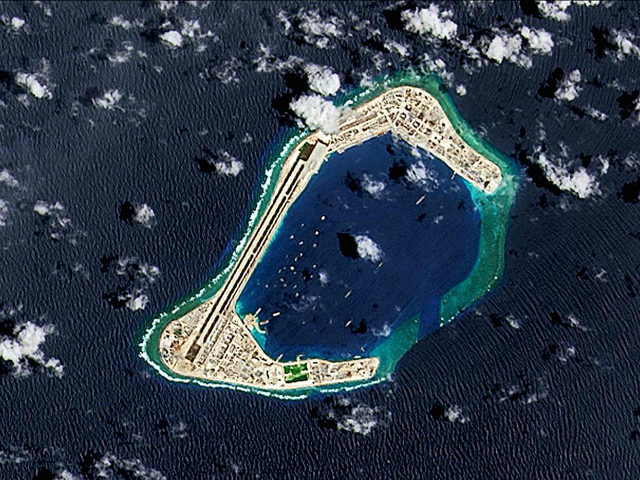China’s state media announced Friday that the People’s Liberation Army (PLA) had executed a military drill in the South China Sea testing target drones in an aerial attack simulation.
The announcement came a day after U.S. Secretary of State Mike Pompeo told Chinese officials in Beijing that Washington is very “concerned” regarding China’s illegal moves in the region.
The South China Morning Post quotes China’s PLA Daily as describing a drill meant to respond to an attack on its navy in the air and involving “three target drones making flyovers of a ship formation at varying heights and directions.” The drones served to “precisely verify the feasibility and effectiveness to ensure a close stimulation of an aerial attack target,” according to the report.
These latest exercises follow a month of changes in the South China Sea. The PLA recently removed some missiles from Woody Island, an island in Vietnam’s Paracel Island chain that China has colonized. The missiles disappeared following the United States flying B-52 bombers through the region. Less than a week later, however, satellite images show that Chinese officials had placed the missiles back in their position, leading some to believe that they had been moved merely for routine maintenance.
At the time, the Chinese Foreign ministry angrily denounced the United States for flying bombers in the region.
“Isn’t it militarization when you send attacking weapons like the B-52 bombers to the South China Sea?” Foreign Ministry spokeswoman Hua Chunying said in a briefing last week. “If someone frequently flexes his muscles or snoops around near your house, shouldn’t you raise your alertness and improve your defense capabilities?”
China claims territory disputed by the Philippines, Vietnam, Malaysia, Brunei, and Taiwan in the South China Sea. The maritime territory China claims as domestic Chinese waters falls under what Beijing calls the “nine-dash line,” which encompasses most of the sea. The Chinese report did not specify where in the vast sea the exercises took place, so it remains unclear whether Beijing used the sovereign territory of a foreign nation to test its latest naval technology.

via Radio Free Asia
The United States has repeatedly challenged China’s claims in the region. The Philippines took China to the Permanent Court of Arbitration at the Hague, which ruled in 2016 that China’s claims were illegal. China continued to build artificial islands and equip them with military assets, anyway, fully disregarding the ruling. Philippines President Rodrigo Duterte has said that he fears a confrontation with China would lead to unnecessary bloodshed for the Philippines in the past, but this year warned he was ready to “go to war” over the region.
The United States has challenged China in the region by executing Freedom of Navigation Operations (FONOPs) through the territory China claims. U.S. Navy assets have passed through there without incident to enforce the law and prevent China from making a claim that no other country uses the international waters for transport.
On Thursday, Pompeo, making his first trip to China, told Foreign Minister Wang Yi that Washington would like to see an end to China’s illegal claims and militarization.
“I reaffirmed our concern with respect to China’s efforts to build a militarized outpost in the South China Sea, endangering the free flow of trade and threatening the sovereignty of other nations and undermining regional stability,” Pompeo told reporters. “I urged Councilor Wang and he confirmed China’s willingness to resolve these disputes in a peaceful way without resort to threats, coercion, or intimidation. I am confident that we can continue to work together towards that end.”

COMMENTS
Please let us know if you're having issues with commenting.